When the American Heart Association released a scientific statement last week recommending that anyone 18 or younger should consume 25 grams or less of added sugar each day, it raised a logical question:
How many grams are kids currently consuming each day?
The answer is startling.
Research shows that our nation's youth consume an average of 75 grams of added sugar per day. That's three times the new recommendation.
Clearly, we have some work to do.
The huge gap also makes it clear that our challenge goes beyond a tweak or two. We need to aim for lifestyle changes -- a new, sustainable plan that revolves around healthier alternatives than the sugary defaults.
For smart, practical guidance on making this conversion, I turned to Dr. Rachel K. Johnson, a co-author of the scientific statement on added sugar and a former chair of the AHA's Nutrition Committee.
Dr. Johnson also is a professor of nutrition and pediatrics at the University of Vermont in Burlington and a wise counsel on these matters; you may recall her joining me in this spot for a smart, practical approach to eating and drinking during the holiday season.
It's my pleasure to turn this important conversation over to her.
***
 Whenever I'm asked about the best way to cut back on added sugars, I always mention the one thing that could make the biggest difference ...
Whenever I'm asked about the best way to cut back on added sugars, I always mention the one thing that could make the biggest difference ...
Watch what you drink!
Beverages are the No. 1 source of added sugars for children and adults. This includes sports drinks, fruit-flavored drinks, sweetened teas and coffees as well as sodas. Since we're focused on kids, my recommendation is that anyone 2 or older should switch from sugary drinks to fat-free or low-fat milk, or to water. (Children under 1 year should have breast milk or formula, and from 1-2 should have whole milk.)
There's really no room in our diets for sugary drinks, particularly among children. The new AHA guidance recommends no more than 8 ounces per week for kids; that's less than a typical can of soda.
Giving up on sugary drinks doesn't mean giving up on savory drinks, though.
Stores are filled with all sorts of flavored seltzers and flavored waters, most of which have far less sugar than other drinks. Better still, put your money into one of those cool infuser bottles and make your own fruit-flavored waters. It's easy and healthy. And it'll go a long way toward cutting daily intake of added sugars.
The second area of emphasis will probably come as no surprise: Desserts.
Or, as we nutritionists call them, sweetened grains. This includes cakes, cookies and pies, as well as things that are seemingly healthy items that are sneaky-sweet, such as some granola bars.
I'm not saying to ditch this group. But I am saying they should be an occasional treat and not a regular part of the diet.
This is also where we need a shift in mindset.
Sweets should not be a reward. Instead, the reward for a job well done (such as finishing homework or a good grade in school) should be something healthy, like the family taking a walk or riding bicycles around the neighborhood.
Another likely culprit in sweetening your child's diet is breakfast, especially pre-sweetened cereals. Sweetened dairy products also fall into that group of sneaky-sweet items, especially flavored yogurts.
Here's a tip that can help you get your day off to a delicious and nutritious start: Use sugar to sweeten already nutritious foods.
For instance, take a plain yogurt or a plain oatmeal and add a little sweetener. Remember, we're not recommending that you eliminate added sugars; you still get 25 grams -- 6 teaspoons -- per day. Use them wisely!
This is a good time to explain a little more about "added sugars." They are exactly what they sound like -- sugars added during the processing or preparation of foods. As for counting them, well, that's a little tricky right now.
Food labels currently list only "sugars," not "added sugars." However, help is on the way. New government regulations will require this key detail to be broken out by 2018. Some companies are planning to do this sooner, which hopefully will become a trend. For now, you can look at total sugars and guess how much is added.
There's an easy workaround for some products. You can even approach it as sort of a game.
Say there's a particular type of flavored yogurt you like. Just find the plain, unsweetened version and compare the sugars. Whatever the difference, that's what has been added.
You can play this game with canned fruit, too. Check the difference between those that use water and those with heavy syrup.
While we're on the subject of comparative shopping, add pasta sauces and ketchups to the list. These, too, are sneaky-sweet items, with less-sweet alternatives possibly just a few inches away.
Comparative shopping is a great way to make small changes that add up to a big difference. It's also a way to fill your pantry and refrigerator with the right things for your children to eat and drink. Simply put, if you don't stock sugary drinks and desserts, your kids are less likely to load up on them.
Now that kids are getting back to school, having healthier ingredients at home also makes it easier to pack healthier lunches. Think of the impact you can have by swapping sugary drinks for water, chips for grapes and so forth. As you start putting together these meals, ask yourself which items have a low-sugar alternative and add those to your shopping list.
The younger your children are, the better chance you have of getting them accustomed to a less-sweetened diet. That is why the new recommendations call for zero added sugars for kids 2 and under. Their diets need to be packed with nutrition.
For those of you with kids 2-18, let me close with one last piece of advice. It's about the sales job to help persuade them to a less-sugary lifestyle.
Make it a journey. Encourage them to eat fewer sweets today than yesterday, and keep working down. Some days are going to be better than others, but the goal is for the overall trend to tilt in the right direction.
Remember, you still get 25 grams or 6 teaspoons per day. And there's nothing wrong with the occasional treat ... as long as those occasions are spread out.
Lastly, I recommend using the buzzwords that connect best with your toddler, tween or teen.
While some may be motivated by reducing their risk of heart disease, diabetes and other known issues that come from poor diets, the majority are more likely to react to other notions that are equally true -- like less sugar leading to a healthier body, enhanced fitness and a more active lifestyle.
Looking good and feeling good? Now those are some sweet goals.

